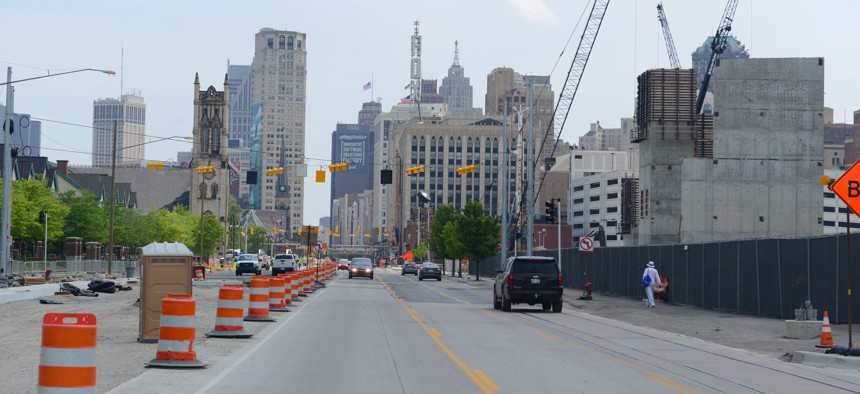County Executives Foil Vote for Detroit Regional Transit Network

Woodward Avenue, looking toward downtown Detroit, in May. Shutterstock
For the umpteenth time, elected officials in Southeastern Michigan fail to cooperate. Can an agreement be saved?
In metro Detroit, the more things change, the more things stay the same.
That was made evident on Thursday, as opposition from Detroit’s suburban neighbors to the north in Oakland and Macomb counties undermined yet another plan to build out a regional transit network for Michigan’s most populous metropolitan area. In a 5-4 vote, the board of the Regional Transit Authority of Southeast Michigan failed to move forward on a regional property tax plan to fund the proposed $4.7 billion system.
As the Detroit Free Press notes, Thursday’s decision leaves “the proposal's fate in limbo even as time runs short for the plan to appear before voters in November.”
Leaders have an Aug. 16 deadline to hammer out a formalized millage proposal to send to voters for consideration.
According to The Detroit News:
Paul Hillegonds, chairman of the RTA’s board, said after the vote in the packed room of the Detroit Regional Chamber office: “This board has gone as far as it can go” on the issue and now elected officials have “to figure it out.”
Hillegonds questioned whether county leaders have the political will to make necessary decisions so that a millage isn’t delayed for two to four years.
The Free Press editorial board lamented on Thursday:
[Macomb County Mark] Hackel and [Oakland County Executive L. Brooks] Patterson's objections show more about our regional fault lines than anything else: Got mine. You're on your own. That's the cynical governing principle that has held metro Detroit back for decades. And it's at the core of what the two executives are doing now, at the last minute, to keep us in the transit dark ages.
The Oakland and Macomb county executives argued that their jurisdictions weren’t getting a fair deal out of the regional proposal, though Hillegonds had previously said he thought the problems could be resolved.
The history of Detroit’s regional cooperation on transportation planning has certainly been tortured, punctuated regularly by intergovernmental acrimony across Eight Mile Road, the jurisdictional boundary separating the City of Detroit and Wayne County on the south with suburban Oakland and Macomb counties to the north.
It took Detroit-area leaders and the state years to come to an agreement to form the RTA, which was authorized by Michigan’s legislature in 2012. The board includes of the county executives in Wayne, Oakland and Macomb counties, the mayor of Detroit, the chair of the Washtenaw County Board of Commissioners.
The RTA’s formation has been the most promising regional development for transit advocates in Southeast Michigan in a generation, but despite that multi-jurisdictional compact, it hasn’t been able to deliver a regional network, built largely around three corridors radiating out into Detroit’s suburbs from downtown.
Back in September 2001, I wrote this for Crain’s Detroit Business, when a proposed regional rapid bus network, then called SpeedLink, was being explored:
But metro Detroit faces key disadvantages with SpeedLink, such as not having a regional transportation agency and not knowing who's going to pay $1.8 billion to develop the system.
SpeedLink, like so many other proposals over the years, fizzled.
Money and cooperation have always been stumbling blocks for expanded transportation options in Southeast Michigan, an area that continues to be largely dependent on its aging regional freeway and expressway network.
The lack of regional transit connections, in particular, between downtown Detroit, Detroit Metro Airport and the University of Michigan in Ann Arbor, place Southeast Michigan at a competitive disadvantage compared to other metropolitan areas that invest considerably more money into transit. (In 2014, the Detroit area spends $69 per capita on transit, while, for instance, Atlanta spends $119 per capita and Seattle spends $471 per capita.)

The state of transit in Detroit isn’t all gloomy, though. Separately, plans for the 3.3-mile M1 Rail streetcar project along a portion of Detroit’s Woodward Avenue, now know as the QLine, solidified and have moved forward into the construction phase. That project is being funded through a public-private partnership, with the U.S. Department of Transportation, state government, city government, private businesses and philanthropies as stakeholders.
But the M1 Rail project, connecting major cultural and entertainment destinations in downtown Detroit with the city’s Amtrak station, will have localized impact. A true regional transit network, as envisioned through the RTA’s Master Plan, will require a multi-county consensus on financing, which hasn’t materialized.
The current RTA Master Plan is built around bus rapid transit routes along three key corridors—Woodward, Michigan and Gratiot avenues—including express bus service to and from Detroit Metropolitan Airport, plus commuter rail service connecting Ann Arbor and Ypsilanti in Washtenaw County with Dearborn and Detroit in Wayne County.
For now, the hopes for those larger transit investments for the region have been stymied. Again.
Michael Grass is Executive Editor of Government Executive’s Route Fifty and is based in Seattle.
NEXT STORY: Austin Gets its First ‘Creative Crosswalk’






